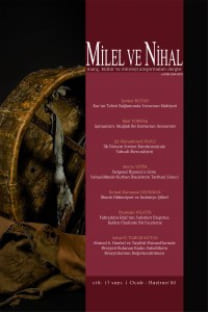Sınırlar, Bölgesel Kimlikler ve Ümmet Tasavvuru
Bu çalışmada ulus-devlet olgusuyla ortaya çıkan modern bölgesel sınırların ulus inşa etme projesinde nasıl işlevsel bir rol oynadığı sosyolojik bir yaklaşımla ele alınmaktadır. Xx. yüzyılın ilk çeyreğinden itibaren İslam dünyasında özellikle de Ortadoğu’da ulus-devletlerin kurulmasıyla birlikte dini toplumsal bir tasavvur ve aidiyet duygusu olan ümmet yerine, ulusal bölgesel kimlikler ikame edilerek bu kimlikler sınırlar aracılığıyla pekiştirilmiştir. Bu süreçte sınırlar hem sert ve geçilmez engeller hem de söylem ve semboller olarak ulus-devletlerin işlevsel aygıtları haline gelerek etnik ve seküler cemaati somutlaştıran/bedenleştiren bir rol üstlenmiştir. Ancak günümüzde ulus-devlet sisteminin zayıflamasıyla birlikte sınırların artık çoğunlukla köprüler olarak işlev görmeye başladığı söylenebilir. Dolayısıyla sınırların yapısındaki bu esnemelerin ulus-ötesi bir Müslüman kimliğin oluşmasına imkân tanıdığını söylemek mümkündür.
Anahtar Kelimeler:
Sınır, ulus-devlet, bölgesel kimlik, Ortadoğu, ümmet tasavvuru.
Borders, Territorial Identities And Imagination Of The Ummah
In this article, the functional role of modern territorial borders which emerges as a nation state phenomenon in the project of nation-building is discussed from a sociological approach. From the first quarter of twentieth century, with the emergence of nation-states in Islamic World, especially in the Middle East, the national-“territorial identities” have substituted with the concept of “ummah “which has a religious social imagination and a sense of belonging, and, these identities were consolidated via borders. In this process, the borders, both as hard and impassable barriers and as discourse and symbols, have become the functional instrument for nation-states. So, they have undertaken the role in concretising the ethnic and secular communities. However, with the weakening of the nation-state system in our days, it can be argued that the borders function mostly as bridges. Thus, it is also possible to say that this flexibility in the structure of the borders enables the emergence of a transnational Muslim identity.
Keywords:
border, nation-state, territorial identity, Middle East, imagination of ummah.,
___
- Abushouk, A. İbrahim (2003), ‚Muslim Unity: Lessons from History‛, International Journal of Muslım Unity, Vol. 1, No: 1. 1-20.
- Ackleson, Jason M. (1999) ‚Discourses of İdentity and Territoriality on the US-Mexico Border‛, Geopolitics, 4: 2, 155–179.
- Aktay, Yasin, (2005), ‚Hilafet Sonrası Şartlarda İslamcılığın Öz-Diyar Algısı‛, Modern Türkiye’de Siyasi Düşünce: İslamcılık, (2. Baskı), (Edi- tör: Yasin Aktay), İstanbul: İletişim Yayınları.
- Anderson, Benedict (2007), Hayali Cemaatler: Milliyetçiliğin Kökenleri ve Yayılması, (4. Baskı), (Çeviren: İ. Savaşır), İstanbul: Metis Yayınları.
- Anderson, Malcolm (1996), Frontiers: Territory and State Formation in the Modern World, Oxford: Polity Press.
- Aydın, Mustafa, (2011), Güncel Kültürde Temel kavramlar, İstanbul: Açılım Kitap.
- Balibar, Etienne ve Wallerstein, Immanuel (2007), Irk, Ulus, Sınıf, (4. Bas- kı)(Çeviren: Nazlı Ökten), İstanbul: Metis Yayınları.
- Bauman, Zygmunt (2009), Sosyolojik Düşünmek (6. Baskı), (Çeviren: Abdul- lah Yılmaz), İstanbul: Ayrıntı Yayınları.
- Bourdieu, Pierre (2006), Pratik Nedenler: Eylem Kuramı Üzerine, (2. Baskı), (Çeviren: H. U. Tanrıöver), İstanbul: Hil Yayın.
- Bulaç, Ali (1998), Modern Ulus Devlet (2. Baskı), İstanbul: İz Yayıncılık.
- Davutoğlu, Ahmet (2002), ‚İslam Dünyasının Siyasi Dönüşümü: Dönem- lendirme ve Projeksiyon‛, Divan, 1-50.
- Diener, Alexander C. and Hagen, Joshua (2010), Borderlines and Border- lands: Political Oddities at the Edge of the Nation-State, New York: Rowman & Littlefield Publishers.
- El Fadl, Khaled Abou (2003), ‚The Unbounded Law of God and Territorial Boundaries‛ (Edited by: A. Buchanan, M. Moore), States, Nations, and Borders: The Ethics of Making Boundaries, Cambridge, Cambridge University Press. 214-227.
- Giddens, Anthony (2008), Ulus, Devlet ve Şiddet (2. Baskı), (Çeviren: Cum- hur Atay), İstanbul: Kalkedon Yayınları.
- Hashmi, Sohail H. (2003), ‚Political Boundaries and Moral Communities: Islamic Perspectives‛ (Edited by: A. Buchanan, M. Moore), States, Nations, and Borders: The Ethics of Making Boundaries, Cambridge, Cambridge University Press. 181-213.
- Karpat, Kemal H. (2009). Osmanlı’dan Günümüze Kimlik ve İdeoloji, (Çevi- ren: Güneş Ayas), İstanbul: Timaş Yayınları.
- Malkki, Liisa (1992), National Geographic: The Rooting of Peoples and the Territorialization of National Identity Among Scholars and Refu- gees, Cultural Anthropology, Vol. 7, No. 1, 24-44.
- Newman, David and Paasi, Anssi (1998). Fences and Neighbours in the Postmodern World: Boundary Narratives in political Geography, Progress in Human Geography, 22, 186-207.
- Paasi, Anssi (1997). ‚Geographical Perspectives on Finnish National İden- tity‛, GeoJournal, 43, 41–50.
- Prescott, J.V.R., Triggs, Gillian D. (2008), International Frontiers and Bounda- ries: Law, Politics and Geography, Martinus Nijhoff Publishers, Lei- den.
- Rooke, Tetz (2006), Tracing the Boundaries: From Colonial Dream to Nati- onal Propaganda (Editör: Inga Brandell), State Frontiers: Borders and Boundaries in the Middle East, London: I.B. Tauris.
- Sack, Robert D. (2009). Introduction, Human Territoriality: Its Theory and History, Cambridge University Press, Cambridge.
- Sayyid, S., (2000), Fundamentalizm Korkusu: Avrupamerkezcilik ve İslamcılığın Doğuşu, (Çev: E. Ceylan ve N. Yılmaz), Ankara: Vadi yayınları.
- Sayyid, S., (2005), İslamcılık ve Postkolonyal Durum, Modern Türkiye’de Siyasi Düşünce: İslamcılık, (2. Baskı), (Editör: Yasin Aktay), İstanbul:
- ISSN: 1304-5482
- Yayın Aralığı: Yılda 2 Sayı
- Başlangıç: 2003
- Yayıncı: Milel ve Nihal: Eğitim, Kültür ve Düşünce Platformu Derneği
Sayıdaki Diğer Makaleler
İslam Şehri’nden Şehir İslamı’na: Tarihsel Tecrübeden Sosyolojik Pratiğe Şehrin Medeniyet Kodları
İlahiyat Sosyolojisi: Bir Sosyal Değişim Dinamiği Olarak İlahiyat Sorunu
Sınırlar, Bölgesel Kimlikler ve Ümmet Tasavvuru
Halil Halid Efendi ve İslam ile Nasrâniyet’in Münasebât-ı Aslîyesi
Bir Yöntem Arayışı Olarak İslam Sosyolojisi
Sosyal Bilimler Bağlamında İslam Sosyolojisinin İmkânı: Paradigmatik Bir Sorgulama
Ziyaüddin Serdar, İslam, Bilim ve Kültürel İlişkiler
Yasin Aktay, Türk Sosyoloji Tarihine Eleştirel Bir Katkı
